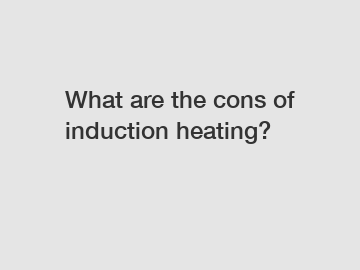What are the cons of induction heating?
What are the cons of induction heating?
Induction heating is a popular technique used in various industries for heating objects using electromagnetic induction. While it offers many benefits such as fast heating, precise temperature control, and energy efficiency, there are also some downsides to this technology. In this article, we will explore the cons of induction heating and how they can impact its applications.
Uneven heating.

One of the main drawbacks of induction heating is that it can lead to uneven heating of the object being heated. This can occur due to the placement of the induction coil, the geometry of the object, or the material properties. Uneven heating can result in inconsistent heating of parts, which can lead to poor quality in the final product. It may also cause issues with thermal stress and distortion in the object being heated.
Limited penetration depth.
Another limitation of induction heating is its limited penetration depth. Induction heating is most effective for heating the surface of the object, but it may not be able to heat the entire volume evenly. This can be a problem for objects with complex geometries or thick walls, where the heat may not penetrate deeply enough to achieve the desired results. In such cases, alternative heating methods may be required to ensure uniform heating throughout the object.
Cost of equipment.
Induction heating equipment can be expensive to purchase and maintain. The cost of the power supply, induction coil, and cooling system can add up quickly, making it a significant investment for businesses. Additionally, the complexity of the equipment can require specialized training for operators and maintenance personnel, adding to the overall cost of implementation. For smaller businesses or those with limited budgets, this can be a significant barrier to adopting induction heating technology.
Safety concerns.
Induction heating involves the use of high-frequency electromagnetic fields, which can pose a safety risk to workers if proper precautions are not taken. Excessive exposure to electromagnetic fields can lead to health issues such as burns, nerve damage, and other adverse effects. Additionally, there is a risk of electric shock if the equipment is not properly grounded or maintained. Companies using induction heating technology must adhere to strict safety guidelines to protect their employees and ensure a safe working environment.
Material compatibility.
Not all materials are suitable for induction heating, which can limit the applications of this technology. Some materials are non-ferrous or have low magnetic permeability, making them difficult to heat using electromagnetic induction. Additionally, certain materials may react unfavorably to induction heating, leading to undesirable changes in their properties or composition. This can be a challenge for industries that work with a wide range of materials and require a flexible heating solution.
In conclusion, while induction heating offers many advantages, it also has its drawbacks that must be considered. From uneven heating and limited penetration depth to high costs and safety concerns, these cons can impact the effectiveness and efficiency of induction heating applications. Businesses looking to implement this technology must weigh these factors carefully and determine if induction heating is the right choice for their specific needs.
Contact us.
If you have any questions about induction heating or would like to learn more about how this technology can benefit your business, please feel free to contact us. Our team of experts is here to help you find the best heating solution for your needs.
Contact us to discuss your requirements of induction hardening machines, auto brazing systems, induction hot pipe bending. Our experienced sales team can help you identify the options that best suit your needs.
154
0
0

Comments
All Comments (0)